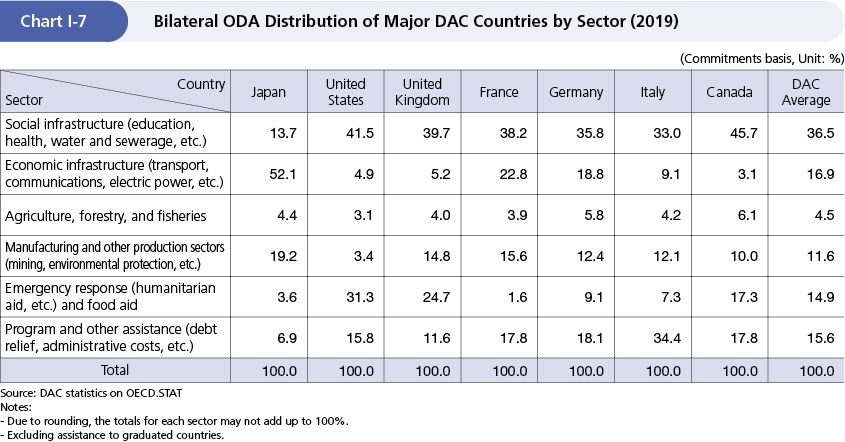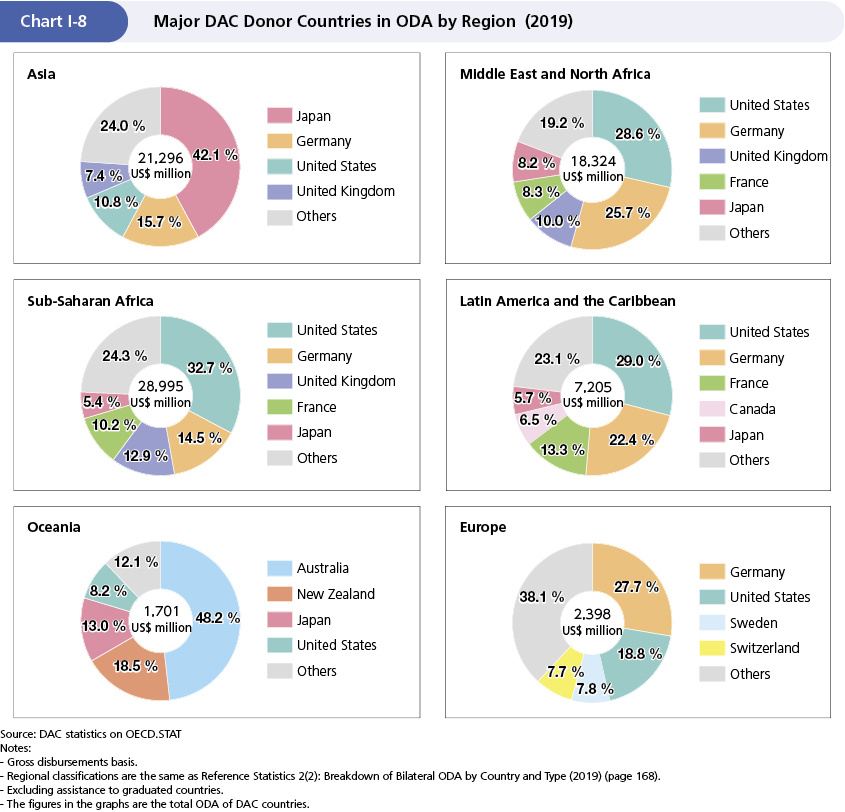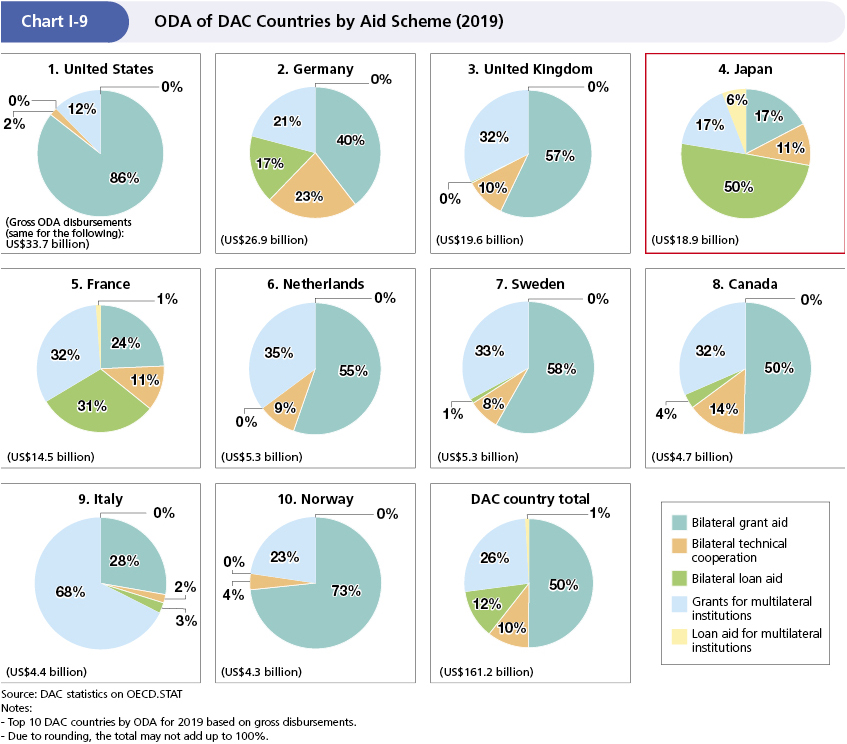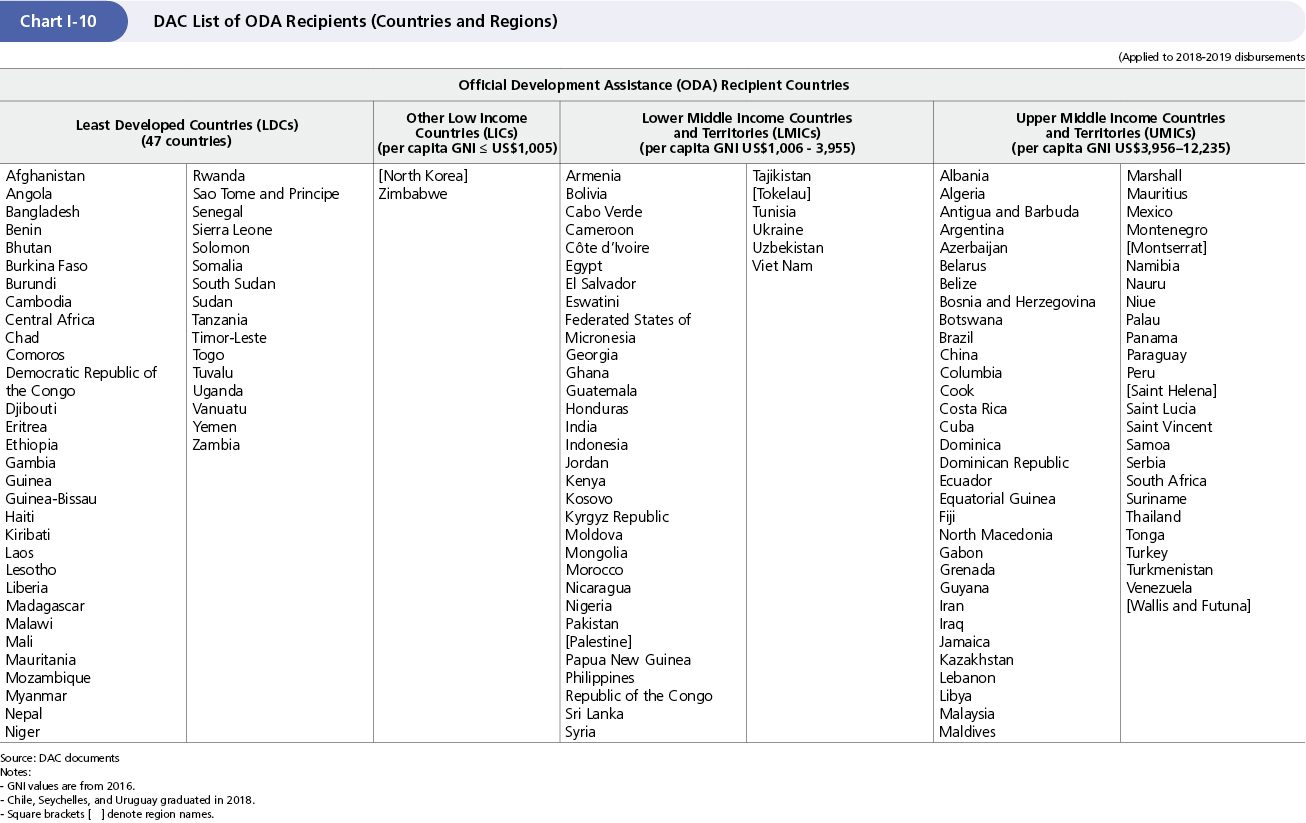(2) Overview of Development Cooperation from Major Donors in Terms of Disbursement
The OECD-DAC has established international rules on what cooperation constitutes ODA and how it should be reported. Under the rules set by the DAC, ODA must meet the following three requirements: (i) it is provided by official agencies or their executive agencies; (ii) its main objective is to promote the economic development and welfare of developing countries; and (iii) it is concessional in character (in the case of loan aid, the terms of the loan [e.g., interest rate and repayment period] are set in favor of the recipient country).
DAC countries provide development cooperation under the rules set by the DAC. However, the content of ODA implemented by major donors varies by country. This section outlines the aid provided by DAC donors, focusing on the G7 countries, based on their disbursements in 2019.
... Aid Disbursements by Majors Donors
ODA provided by DAC countries in 2019 (calculated by GE system) amounted to approximately $151,722 million. By country (GE system, percentage out of total ODA of DAC countries), the United States ranked first (approximately $33,492 million, 22.1%), Germany second (approximately $24,198 million, 15.9%), the United Kingdom third (approximately $19,393 million, 12.8%), Japan fourth (approximately $15,588 million, 10.3%), France fifth (approximately $12,211 million, 8.0%), the Netherlands sixth (approximately $5,292 million, 3.5%), Sweden seventh (approximately $5,205 million, 3.4%), Canada eighth (approximately $4,725 million, 3.1%), and Italy ninth (approximately $4,373 million, 2.9%), with the G7 countries occupying the top spots Note 8.

... Sectors Aided by Major Donors
Disbursements in 2019 from the United States, United Kingdom, Canada, France, and Germany were concentrated in the social infrastructure sectors, including education, health, and water supply and sewerage. The United States allocated more than 30% of its total ODA to emergency relief such as humanitarian assistance and food aid. On the other hand, in the economic infrastructure sectors, such as roads, bridges, railroads, communications, and electricity, Japan ranked first with 52.1% of its total ODA, followed by France with 22.8%. Economic infrastructure assistance makes up a large share of Japan’s cooperation because Japan, with its postwar recovery experience, considers that, in order to achieve poverty reduction and other goals through sustainable economic growth in developing countries, it is essential first and foremost to establish economic infrastructure and support the self-help efforts of developing countries (Chart I-7).
... Regions Aided by Major Donors
Whereas Japan’s ODA is primarily directed at the Asian region (approximately 61.1% of gross disbursements in 2019 [hereinafter the same]), Sub-Saharan Africa was the top recipient of aid from the United States, France, the United Kingdom, and Italy (32.1%, 30.8%, 28.1%, and 22.8%, respectively). The Middle East and North Africa was the top recipient of aid from Germany (22.2%) Note 9 . In terms of percentage out of total aid disbursements from major DAC countries by region, the United States was the largest donor to Sub-Saharan Africa (32.7%), the Middle East and North Africa (28.6%), and Latin America and the Caribbean (29.0%). Australia provided 48.2% of total ODA to Oceania, while Germany accounted for 27.7% of total ODA to Europe, including the former Yugoslavia and Ukraine. As these figures indicate, the regional priority of each donor is also influenced by factors such as geographic proximity and historical background (Chart I-8).

... Disbursements by Type of Assistance (2019)
By type of assistance, approximately 87% of ODA provided by all DAC countries in 2019 were grants (bilateral grant aid: approximately 50%; bilateral technical cooperation: approximately 10%; grants to international organizations: approximately 26%), and 13% were loan aid (bilateral: approximately 12%; loans to international organizations: approximately 1%). With the exception of Japan and France, major DAC countries implemented most of their ODA as grants (grant aid and technical cooperation) (Chart I-9).
Loan aid (e.g., ODA loan) accounts for a large share of Japan’s ODA because Japanese assistance aims to support developing countries’ self-reliant efforts to achieve economic growth. This is based on the idea that effective development cooperation requires awareness raising that development is not granted; rather, it is something developing countries take ownership of. From the viewpoint of developing countries, they carry out projects aimed at their social and economic development with the funds they have borrowed. This in turn encourages the countries to work hard on their projects. Japan’s cooperation strives to enable the people of developing countries to sustain and evolve the projects on their own even after Japan’s ODA loan projects are completed. This approach is unique to Japan, which places importance on self-help efforts, and its effectiveness was acknowledged in the DAC development cooperation peer review (see “DAC Development Co-operation Peer Review of Japan”).

... Development Cooperation from Emerging Donors
In addition to the DAC countries that have traditionally provided development cooperation, recent years have seen an increase in aid provided by non-OECD or non-DAC new donors and private foundations. Those new donors consist of developing countries that have achieved economic development, such as China, India, Indonesia, Saudi Arabia, Brazil, Argentina, Mexico, Turkey, and South Africa. The total amount of aid provided by these new actors in development cooperation, according to DAC Statistics alone, is more than $16 billion by non-DAC countries (only those countries that have reported to the DAC) and more than $45 billion by NGOs.
It is essential to accurately grasp the flow of funds to developing countries and to effectively utilize limited development financing in order for the international community to promote development cooperation in a coordinated manner. However, the statistics prepared and published by the DAC do not reveal the full details of aid provided by non-DAC countries and other donors. It has also been pointed out that some donors are providing development cooperation that does not necessarily conform to the three requirements of ODA, as stipulated by the DAC, and that loans to developing countries in particular are being provided in a non-traditional and non-concessional manner, such as collateralized loans.
Discussions are under way at the OECD and various other international fora to create rules and frameworks for international aid, including aid from these emerging donors and use of private financing. The Communiqué adopted at the OECD-DAC High Level Meeting held in November 2020, through efforts of Japan, included a call for non-DAC providers of development cooperation to adhere more closely to international standards and practices to improve transparency and accountability in development cooperation. Japan will continue to work with the international community to ensure that the development cooperation of emerging donors including China is transparent and consistent with international standards and initiatives (see “ODA Topics,” regarding the new international statistical system, Efforts on Debt Issues regarding efforts to address debt issues, and Partnership with Other Countries and
International Organizations regarding cooperation with other countries and international organizations).

- Note 8: Details are available in Development Cooperation Reference Materials 2020, Chart “ODA by DAC Countries (2019)” (in Japanese only).
- Note 9: Details are available in Development Cooperation Reference Materials 2020, Chapter 3 Economic Cooperation of Other Countries, Section 3 “Overview of Economic Cooperation of Major Donors and Regional Organizations” (in Japanese only).
